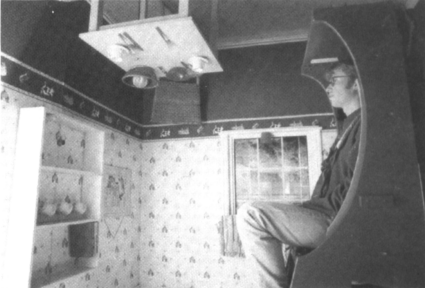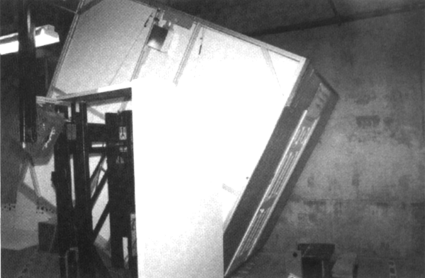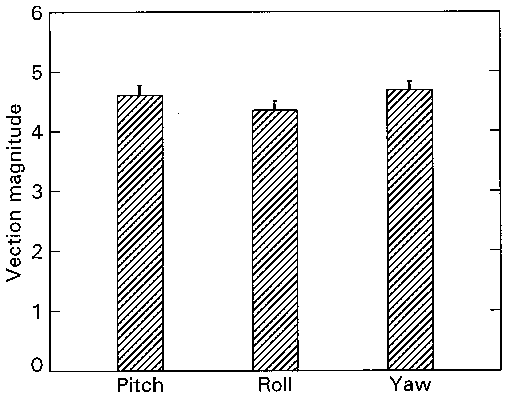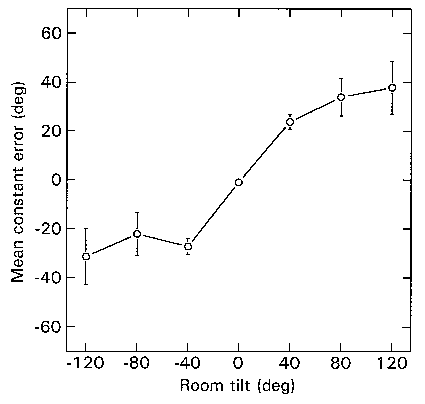Chapter 4
Illusory self-tilt
in a "Tumbling Room"
Introduction
Rotation of a visual display about an earth-horizontal axis
induces a sensation of continuous self-motion accompanied by a sensation of
self-tilt in the opposite direction, or equivalently an apparent tilt of the
subjective vertical in the same direction (Dichgans and Brandt 1978). The degree
of illusory self-tilt is determined by several factors. First, the effect increases
with the area of the rotating display, especially when the stimulus motion expands
to the retinal periphery (Held et al. 1975). Second, illusory self-tilt
is a function of stimulus velocity, but only up to about 40º/s (Held et al.
1975; Howard et al. 1988). Third, the strength of the effect depends
on the orientation of the head relative to gravity. The effect is stronger when
the head is tilted 90º to the side, or inverted, as compared to erect (Young
et al. 1975; Dichgans et al. 1975). Additionally, the axis of
rotation relative to the subject may be important too. It was found that illusory
self-inclination is larger for backward rotation of the scene about the subjects’
y-axis (pitch) compared to forward pitch motion (Young et al. 1975).
In general, the average maximum illusory body inclination does not exceed 20º,
which is attributed to the restraining influence of the otolith organs.
Furthermore, illusory self-tilt depends
on the type of visual information in the display. Three types of visual cues
contribute to the sense of body orientation with respect to gravity: visual
motion, visual frame, and visual polarity. A visual frame is a set of lines
and surfaces that constitute a frame which is normally aligned with gravity.
Visual polarity comprises objects which show a identifiable "up" and
"down". Visual motion alone can be obtained by rotation of a display
with a texture lacking visual frame and visual polarity cues. Most studies on
visually induced self-tilt have applied rotating displays textured with non-polarized
dot patterns. Recently, Howard and Childerson (1994) used a 7 feet cubic room,
which contained distinct cues for visual frame and visual polarity, and which
rotated about the subjects’ roll-axis. In total, 60% of the upright subjects
reported a compelling sensation of complete self-rotation, meaning that the
information of the graviceptive sensors was completely overridden by the dominant
visual stimulus. The other 40% of the subjects experienced a limited degree
of self-tilt, either constant or alternating. During the latter, the subjects
perceived self-tilt with the body becoming erect each time a surface became
horizontal. Some subjects noted the feeling that they were supine and experienced
self-rotation about a vertical roll-axis.
The so-called "Tumbling Room"
used by Howard and Childerson was rebuilt to make it more realistic and provide
it with a richer variety of polarized objects. The study described here was
performed using this new Tumbling Room, with the following objectives: (1) Determine
the percentage of subjects that perceive full self-rotation when immersed in
a highly polarized scene. (2) Examine the effects of body posture on illusory
self-tilt produced by rotation of the room (in the previous study the subjects
sat in an erect posture). (3) Compare the effects of rotation of the room for
different viewing directions of the subject relative to the room (roll, pitch,
or yaw). Because the results showed that the rotating Tumbling Room was very
effective in producing sensations of complete self-rotation, it was of interest
to know whether (4) static tilt of the room could induce sensations of self-tilt
which exceeded previously reported illusory self-tilt in response to static
tilt of visual scenes. This question was addressed in an additional experiment
by testing erect subjects with rotation about the roll axis only.
Methods
Furnished room
The furnished room consisted of an 8 foot cubic frame lined
with plywood on the floor and foam plastic sheets on the walls and ceiling (Figure
4.1). One side wall had a window with a lighted outdoor scene, a valance curtain
and plants. The opposite wall had an interior house door that allowed access
to the room. The walls were papered and decorated with pictures, hanging objects,
and a bookcase holding books, a teddy bear and three cups hanging from cup hooks.
There was a small kitchen table screwed to the floor, set with cutlery, plates,
cups and saucers, a bread basket and a box of tissues. Two wicker chairs either
side of the table completed the scene. The floor was carpeted and there were
baseboards against the walls, and additional floor details included waste baskets
and slippers. All objects were carefully held in place by either hidden bolts,
glue or Velcro, so that they stayed in place when the room rotated. In the center
of the ceiling was a simple 60W fluorescent light fixture with a plastic cover.
Thus, the room provided a clear visual frame and a rich variety of visual information
about which direction was up and which direction was down.


Figure 4.1. The interior
of the furnished Tumbling Room (upper picture) tilted 180º. A variety of objects
was fastened to the walls and floor. The room rotated about a fixed earth-horizontal
axis (lower picture). By changing the orientation of the chair, the effective
rotation axis relative to the subject could be varied between roll, pitch, or
yaw.
Bearings were placed
on the centers of an opposite pair of walls and the whole structure was mounted
on external brackets so that it could be rotated about a horizontal axis passing
through the center of the room. Room rotation was generated by a computer controlled
DC servomotor. The subject was strapped into a seat supported on a 10 inch square
boom which protruded through one wall along the axis of rotation of the room.
The chair could be removed and replaced by a bed, which was suspended between
the boom on one side and a shaft on the other side of the room.
Constant velocity
rotation of room
Profile
The room rotated about an earth-horizontal
axis at a constant velocity of 30º/s for 4 cycles over a period of 48 s. The
initial acceleration and final deceleration were 5 º/s2 applied over
a period of 6 s. The lights were on all the time and the subjects looked straight
ahead at the center of the wall in front of them.
The first experimental variable
was the rotation axis with respect to the subject. The subject was placed in
each of three postures so that the room rotated about the subject’s roll, pitch,
or yaw axis. For roll, the subject was looking along the axis of room rotation.
For pitch, the chair was turned so that the subject was facing the side wall
with the door. For yaw, the chair was replaced by the bed with the subject lying
along the axis of rotation of the room. The second variable was body orientation.
In roll, the subject was seated upright, tilted left ear down or right ear down.
In yaw, the subject was lying either in supine position, or with left ear down
or right ear down. In pitch, the subjects were seated upright or pitched backwards
90º into supine posture, but they were not pitched forward, since this would
have been an awkward position. Finally, the direction of room rotation was either
clockwise or anti-clockwise. The 16 conditions were arranged in blocks per rotation
axis. The order of conditions within each block and the order of blocks was
counterbalanced over subjects. Additionally, conditions were alternated for
direction.
Responses
Thirty-two subjects (of whom 12 were
familiar with the purpose of the experiment) were tested in each of 16 conditions.
Subjects were asked to report their sensations of self-tilt according to the
following categories (Howard and Childerson 1994): (a) "Full tumbling",
subjects felt as if they had rotated completely through 360º. (b) "Alternating
self-tilt", subjects felt that they were rotating opposite to the room
to a certain angle of self-tilt, then felt suddenly upright, and then began
tilting again. (c) "Constant self-tilt", subjects felt inclined at
a more or less constant angle in the opposite direction of room motion. (d)
"Supine", subjects felt as if they were lying supine, looking up at
the rotating display that now appeared to be rotating in a horizontal plane.
(e) "No effect", subjects did not experience self-tilt but felt veridically
upright.
The subjects were also asked to rate
the magnitude of their sensations of self-motion (vection) on a seven point
scale (0 - only room motion; 1 - much more room motion than self; 2 - more room
than self; 3 - equal room and self; 4 - more self than room; 5 - much more self
than room; 6 - only self-motion).
Static
tilt of room
Profile
The subject sat erect in the chair with the head near the
center of the furnished room. The room rotated about the subject’s roll axis
and brought to rest at one of four angles with respect to the vertical. While
the room was moving, subjects kept their eyes closed for a fixed time so that
the duration of eye closure could not indicate how far the room had moved. The
angles of scene tilt were 0, 40, 80, and 120º, either clockwise or anti-clockwise.
There were thus seven conditions, each repeated four times per subject.
Response
Subjects indicated their subjective
vertical by aligning two black one-inch diameter discs ("indicator")
with the apparent vertical. The discs were placed on a transparent circular
disc about 1 foot in diameter which was mounted at its center on a horizontal
shaft protruding from the axis of room rotation in the facing wall, about five
foot in front of the subject. The setting of two dots was preferred to the setting
of a line because of possible tilt contrast effects between a line and the room.
The subject could set the disc to the desired angle by means of a servo device
which controlled a motor attached to the disc shaft. There was some overshoot
each time the disc rotated. However, subjects quickly learned to handle the
rotating device with a minimum of overshoot. Six subjects were tested in each
condition, making 168 randomized and counterbalanced trials.
Results
Constant velocity rotation
The rotating room induced compelling
sensations of self-rotation about an earth-horizontal axis. Subjects were aware
that the pressure sensations acting on the five-point harness were not what
they expected from full self-rotation but this did not prevent them from feeling
that they had rotated through 360º. After completing the experiment, several
subjects found it difficult to believe that they had remained stationary and
the room had been rotated. The percentages of the different kinds of sensations
produced by room rotation are set out in Figure 4.2 for each axis of rotation.
There were no significant effects of the factors rotation axis, body orientation,
or direction of rotation on the type of self-rotation (tested with Pearson’s
Chi-square). In total, 83.8% of the 512 responses were "full tumbling";
8.4% were "alternating self-tilt"; 5.5% were "constant self-tilt";
and 2.3% were "no effect". The number of subjects that accounted for
these percentages are shown above the bars in Figure 4.2 (in fact, these numbers
indicate how many subjects experienced the regarding sensation in at least one
of the trials). There were no "supine" responses.

Figure 4.2. Percentage of all 512 responses (32 subjects in 16 conditions)
for each category of illusory self-tilt in the tumbling room for each axis of
rotation with respect of the subject’s body for a constant room velocity of
30º/s. The numbers above the bars indicate the number of subjects who experienced
the corresponding sensation at least once.
Mean vection magnitude over the 32
subjects for room rotation about the subject’s roll, pitch, and yaw axes are
shown in Fig. 4.3. Vection data were subjected to an ANOVA (within subjects
design). There were no significant effects of rotation axis, body orientation,
or direction of rotation. Vection was on average relatively well saturated with
an average of 4.6 (st. dev.1.8), which means that - except for some residual
sensation of room motion - most of the visual motion was attributed to self-motion.

Figure 4.3.
Mean vection magnitude in the tumbling room for each axis of rotation with respect
to the subject’s body during constant room velocity of 30º/s. Bars are standard
errors of the mean (n=32).
Static
tilt
The mean subjective vertical (constant
error from true vertical) and the mean variable errors (standard deviation)
are shown in Figure 4.4. There was a significant main effect of scene tilt angle
on the subjective vertical (F=4.99; df=3; p<0.05), but only between 0º and
40º (post-hoc Tukey: p<0.05). There was a non-significant trend for the effect
of room tilt on the variable error between the four repetitions per condition
(F=3.0; df=3; p=0.06). The data from the condition in which the room was vertical
show that the accuracy of the settings was quite good. On average, the visual
stimulus was set at -1.1º, that is, slightly anti-clockwise from the true vertical.
The precision was 1.5º (mean standard deviation).


Figure 4.4.
Mean constant error (a) of the vertical setting of the indicator (subjective
vertical) for each angle of room tilt (six subjects with four measures per condition).
Corresponding mean variable errors (b) of the subjective vertical for each angle
of room tilt. Bars are the standard errors of the mean. (Click to enlarge graphs)
Figure 4.5 shows the
distribution of all settings of the indicator to vertical. For 40º of room tilt,
some subjects aligned the indicator with the room, while others showed only
a tendency to align it with the room. In only one trial of one subject was the
indicator set in the opposite direction of the room. For larger angles of room
tilt, 80º and 120º, the response varied greatly between subjects. One subject
(S6) aligned the two dots almost exactly with the tilted room in all conditions.
Another subject (S4) sometimes reported that the indicator appeared vertical
when it was close to being aligned with the room and sometimes when it was close
to the actual vertical. There was no time limit in setting the indicator, and
this subject kept rotating it over large angles before making a decision. As
a result, his settings for 80º and 120º scene tilt were rather scattered. Two
other subjects (S1, S3) consistently set the indicator close to the true vertical.
Finally, two other subjects (S2, S5) seemed to use either the real floor or
the surface that was closest to horizontal as the apparent floor. This resulted
in a bimodal distribution of their responses which is reflected in the mean
distribution settings over subjects in Figure 4.6. The settings of the indicator
for each subject are shown in Figure 4.5.

Figure 4.5.
Settings of the indicator to the apparent vertical for each subject.

Figure 4.6. Distribution of
vertical setting of the indicator for each angle of room tilt, collected in
5º intervals. Data from clockwise and anti-clockwise trials collapsed (n=6;
4 repetitions for each angle of room tilt). Positive angles indicate that the
stimulus was rotated from the true vertical in the direction of the room (with
the exception of the upright room condition, where the sign is not related to
the room tilt, but illustrates the accuracy of the indicator setting).
Discussion
Constant velocity
rotation
All subjects experienced complete
self-rotation (self-tilt through 360º) in most of the trials when exposed to
rotation of the furnished room. Over 80% of the responses were "full tumbling".
Subjects also experienced strong sensations of self-motion (vection) whether
or not they experienced full self-rotation. In the furnished room used by Howard
and Childerson (1994), 60% of subjects reported full self-rotation. This room
was smaller and contained less polarized visual features. There have been no
other scientific reports of sensations of full self-rotation produced by visual
stimulation alone in the presence of restraining information from the otolith
and somatosensory organs. People experienced full tumbling in the "haunted
swing", a fairground device that was built towards the end of the last
century (Wood 1895). The room rotated about the pitch axis, while the observers
sat in a stationary gondola with their heads several feet below the axis of
rotation. In this case, the information of the otolith organs was not necessarily
contradictory with the simulated motion, since the resultant G-force would have
stayed approximately in line with the body axis when the gondola were to have
actually rotated. In the present study the observer’s head was near the axis
of rotation, so that during actual body rotation the otolith organs would have
indicated self-tilt. The high rate of full tumbling therefore demonstrates that
immersion in a rotating polarized scene can fully override the restraining otolith
organ and semicircular canal inputs.
There was no difference in incidence of self-rotation
sensations between the three axes of rotation: roll, pitch, and yaw. Nor was
there a measurable effect of body orientation with respect to gravity. Previous
reports showed that vection magnitude is larger for yaw rotation than for pitch,
which in turn is larger than for roll (Howard et al. 1988). Moreover, visually
induced self-tilt and self-rotation normally increase when the body is inclined
to gravity (Young et al. 1975). The reason that these effects were not found
in the present study must be due to the general effectiveness of the furnished
room. Presumably the response was already saturated in an upright body posture,
and tilting the body could not add to this.
Static tilt
Subjects were most consistent in setting the visual display
to the apparent vertical when the furnished room was upright. The variable errors
were comparable to those reported by Witkin and Asch (1948). When the room was
tilted 40º the position of the apparent vertical shifted in the direction of
room tilt and was equal to room tilt for some subjects. For tilt angles of 80º
and 120º, responses became highly variable. Subjects became confused and their
disorientation sensations were less stable. Some subjects fluctuated between
two criteria of verticality: the room, as indicated by the visual polarity,
and the actual direction of gravity as signaled from the otolith and somatosensory
sense organs.
Asch and Witkin (1948a) had subjects stand in the laboratory
and look into a furnished room tilted 22º. Settings of a rod inside the room
to the apparent vertical were displaced on average 15º in the direction of room
tilt. A simple tilted frame produced an apparent tilt of only 6º. In the present
experiment subjects were immersed in the tilted room, and the angles of scene
tilt were larger. This resulted in larger effects. In a similar study, Howard
and Childerson (1994) observed on average only 15º at 40º of room tilt, with
a maximum of 60º. At larger angles of scene tilt, there was a strong tendency
of the subjects to use the surface-closest-to-horizontal as subjective floor.
In the same study, results were compared to the effects of a framed room without
any polarity. The results were similar, except for 40º of room tilt, where subjects
in the framed room took the diagonal (a 45º tilted square frame may be seen
as an erect diamond with a "vertical" at 45º intervals).
Conclusion
It is concluded that a static, richly polarized visual scene
in which the subject is immersed can induce illusions of self-tilt far greater
than previously reported. However, for most subjects, a static polarized room
is not as effective as a rotating room in inducing strong illusory self-tilt.
The full self-rotation experienced by most people when immersed in a richly
polarized and moving visual environment, such as the rotating furnished room,
must represent the combined effect of motion, visual frame and the polarity
features in the room. With the rotating room subjects were generally consistent
in their responses and did not report the ambiguity that they experienced in
the static tilted room.
Acknowledgments
This study was performed at Dr. Ian Howard’s Human Performance
Laboratory of the Institute for Space and Terrestrial Science (located at York
University, Toronto, Canada). Financial support was provided by Dr. Bob Cheung
of the Defence and Civil Institute for Environmental Medicine (DCIEM) under
contract No. W7711-5-7256. I would especially like to thank Heather Jenkin for
her help in running the experiments.






